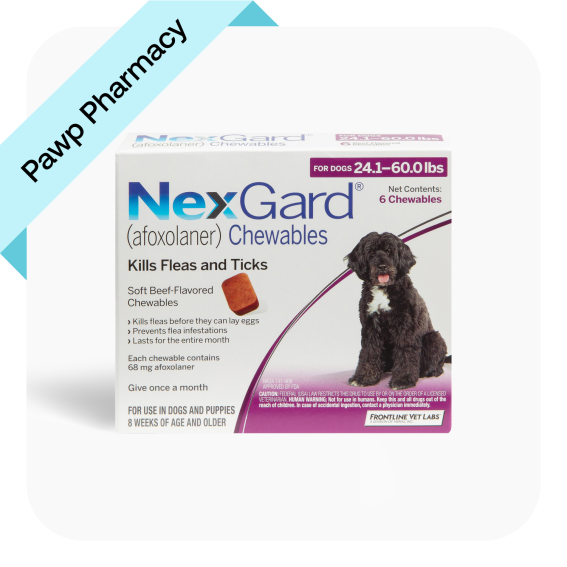Pet parents often hear about the importance of flea & tick prevention, especially in the spring and summer months when these pests tend to be more common. We’re encouraged to give our pets preventative medication, diligently look for signs of itchiness and skin irritation, and regularly check for parasites in our pup’s fur.
While this may seem like a lot of work to avoid tiny pests, the dangers of fleas and ticks go far beyond your dog being a little itchy. These pesky parasites can also spread bacteria and illness—one of which is Lyme disease.
What is Lyme disease in dogs?
Lyme disease is a bacterial illness spread by the blacklegged tick (Ixodes scapularis).
The disease can spread throughout the body, but typically localizes in parts of the musculoskeletal system, such as the joints. In some cases, the illness focuses on the kidneys. This can lead to renal disease, which is a much more serious ailment.
We don’t always know how Lyme disease will present, and it can show up in a variety of ways. In fact, it can take up to a year for a dog to show symptoms of Lyme disease after infection, if they show any symptoms at all.
Symptoms of Lyme disease in dogs include:
Fever
Swollen lymph nodes
Lethargy
Loss of appetite
Stiffness & pain
Swollen joints
Lameness
How do dogs get Lyme disease?
Dogs get Lyme disease through a tick bite. The blacklegged tick (which is also called a deer tick) spreads Lyme disease to dogs and humans by biting them and transmitting a bacterium called Borrelia burgdorferi into the bloodstream.
While cases of Lyme disease tend to concentrate in the northeast, upper midwest, and far west, it can be obtained anywhere in the country due to travel. Endemic areas of the northeast are considered the highest risk, where it’s estimated that 50% to 90% of these ticks are infected with the bacterium that causes Lyme disease.
It’s also important to note that dogs who spend a significant amount of time outside aren’t the only ones at risk for tick bites and Lyme disease. Ticks are everywhere, and although not all tick species carry Lyme disease, it’s wise to avoid them altogether.
How is Lyme disease in dogs diagnosed and treated?
To diagnose Lyme disease in dogs, a veterinarian will perform a blood test that checks for bloodborne illnesses. They may also do a physical examination of your dog to check for symptoms like joint swelling and enlarged lymph nodes.
Interestingly enough, some dogs who are positive for Lyme disease do not show symptoms. In these cases, a veterinarian will assess the risk and decide whether or not to treat your dog. Some veterinarians believe that if you don’t treat asymptomatic dogs, there’s a low risk that those symptoms eventually show up. This, however, is up to the veterinarian’s discretion.
If your dog has Lyme disease and does show symptoms, a veterinarian will typically prescribe a 4-week course of antibiotics. This will address the bacteria in your dog’s system, but any symptoms need to be managed as well.
For example, if there is kidney involvement, your veterinarian will also provide treatment that supports kidney function, be it fluids, a diet change, or regular blood work—although kidney function isn’t something that can return to pre-infection levels. If the Lyme disease is causing joint issues or musculoskeletal pain, the veterinarian may help address this discomfort by giving pain medication.
What should I do if my dog has Lyme disease?
Once a vet diagnoses your dog with Lyme disease, it’s important to follow their advice for how to keep your dog comfortable and healthy.
Whether they recommend pain medication, a diet change, or regular follow-up appointments, they’ll know how to best help you care for your dog. It’s wise to continually observe your dog closely for any changes in behavior or health and ensure you communicate these with your vet.
How to prevent Lyme disease in dogs
The best thing you can do to prevent Lyme disease in dogs is to get your pup on a flea & tick preventative. There are a wide range of options on the market, and a veterinarian or Pawp Pro will be able to help you choose the best option for your dog based on their health, weight, and lifestyle.

NexGard Chewable, 24.1-60 lbs, (Purple Box), Rx$30
If you're a Pawp member you can purchase your flea and tick medication through the Pawp Pharmacy. You will already need to have a prescription.
Make sure you administer the medication correctly and on time to increase its effectiveness. Some oral flea and tick preventatives work best when given with a meal, so be sure to check the directions on the label.
Depending on where you live and your lifestyle, your vet may also recommend the Lyme disease vaccine. If you frequent wooded areas with your dog or live in the northeast where this is endemic, this could potentially be beneficial.
Lastly, it’s important that every time you come home, you run your hands along your dog’s fur to do a quick tick check. Interestingly enough, it takes 24-36 hours for the tick to start giving Lyme disease to the dog once they're bitten, so if you see a tick, remove it (or get it removed by a veterinarian) as soon as possible. Removing a tick properly is important to ensure you have removed the body and the head. There are tick removing tools that you can purchase for home use. Check your local pet store or an e-commerce site that carries these products. If you catch it early, it’s very unlikely that the tick has transmitted Lyme disease.
If you suspect that your dog has Lyme disease, the team of experts at Pawp is here to advise you on next steps. We're here 24/7 and no appointment is required.

Reviewed and fact-checked by
Mika, RVT at Pawp
